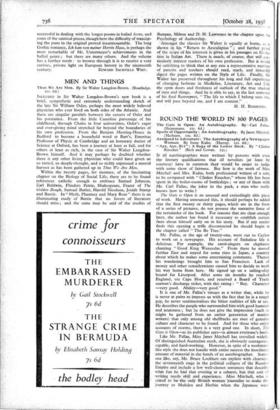MEN AND THINGS
INCLUDED in Sir Walter Langdon-Brown's new book is a brief, sympathetic and extremely understanding sketch of the late Sir William Osler, perhaps the most widely beloved physician who ever lived on both sides of the Atlantic. And there are singular parallels between the careers of Osier and his portraitist. From the little Canadian parsonage of his childhood, through Chairs in four universities, Osler's eager and ever-giving mind stretched far beyond the boundaries of his own profession. From the Bunyan Meeting-House in Bedford to become a household word at Bart's, Emeritus Professor of Physic at Cambridge and an honorary doctor of Science at Oxford, has been a journey at least as full, and for others at least as rich, in the case of Sir Walter Langdon- Brown himself. And it may perhaps be doubted whether there is any other living physician- who could have given us so varied, so deeply-thought, and -so richly expressed a mental harvest as has been gathered up in Thus We Are Men.
Within the twenty pages, for instance, of the fascinating chapter on the Biology of Social Life, there are to be found references catholic enough to embrace Saniuel Johnson, Earl Baldwin, Flinders Petrie, Shakespeare, Frazer of The Golden Bough, Samuel Butler, Harold Nicolson, Josiah Stamp and Barrie. In "Myth, Phantasy and Mary Rose ". there is an illuminating study of Barrie that no lovers of literature should miss ; and the same may be said of the studies of Bunyan, Milton and D. H. Lawrence -in -the -chapter upon the Psychology of Authorship.
'Amongst the classics Sir Walter is equally at home, as is shoWn in his "Return to Aesculapiu.s " ; and further proof of the scope of his interests is given in his passages on Evolu- tion in Italian Art. There is much, of course, that will par_ ticularly interest readers of his own profession. But it would be satisfying to think that at any rate a representative number of parents and teachers should read, mark, and inwardly digest the pages written on the Style of Life. Finally, Sir Walter has preserved throughout his long and full experience of changing fashions in Medicine, Literature, Art and Life the open doors and freshness of outlook of the true student of men and things. And he is able to say, in the last sentence of his final Retrospect, " The life to which I belong uses me, and will pass beyond me, and I am content."
H. H. 13asttFoao.
























































 Previous page
Previous page